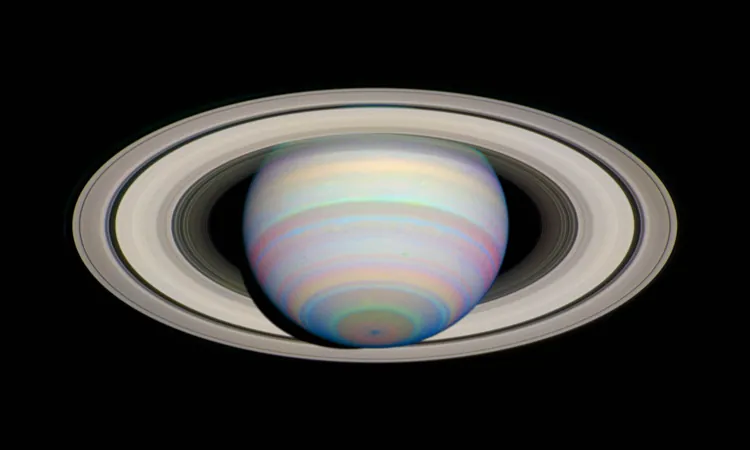
Time is Running Out: Saturn's Breathtaking Rings Will Disappear Soon!
2025-01-10
Author: Ken Lee
Saturn, the jewel of our solar system, has long captivated the imaginations of astronomers and stargazers alike with its stunning rings. For centuries, this celestial giant has been a source of curiosity, but it seems the curtain is about to fall on one of its most famous features. In just three months, Saturn's iconic rings will vanish from our view, leaving only a pale yellow sphere in its place.
A Brief History of Saturn's Rings
In the early 17th century, the Italian astronomer Galileo Galilei was the first to gaze upon Saturn through a telescope. He misinterpreted the planet's appearance as having 'ears,' due to the limited technology of his time. Yet, he sensed something extraordinary about this distant world. With the advent of powerful telescopes and space missions, we have come to understand that Saturn's rings are complex structures made of ice and rocky debris, influenced by the gravitational forces of the giant planet and its numerous moons.
A Cosmic Phenomenon: The Ring Plane Crossing
On March 23, 2025, an astronomical event known as the 'ring plane crossing' will occur. During this rare alignment, Saturn's rings will appear edge-on to Earth, making them nearly invisible to the naked eye and through standard telescopes. This view will leave Saturn looking like a featureless yellow ball, with only a faint trace of its rings visible through the most advanced equipment.
This extraordinary celestial alignment unfolds as a result of Saturn's axial tilt, altering our perspective. While some might lament the temporary disappearance of the rings, this phenomenon offers a unique opportunity to witness the dynamic nature of celestial motions—a reminder that such changes are part of a grand cosmic dance.
The Return of the Rings
Fear not, ring enthusiasts; this isn’t a permanent farewell. By November 2025, as both Earth and Saturn continue their orbits, the rings will once again come into full view. Once bright and glorious, they will dazzle our telescopes anew, accompanied by glimpses of Saturn's many moons.
A Deeper Dive into Saturn's Rings
Saturn's rings are not simply solid structures but are composed of countless particles ranging from tiny grains of dust to massive boulders. Scientists classify the rings into sections: the A, B, and C rings, with fainter rings designated as D, E, F, and G. The Cassini Division, a prominent gap of 2,982 miles wide between the A and B rings, was formed from gravitational interactions and orbital mechanics.
One popular theory suggests that Saturn's rings may have originated from a moon that was torn apart by the planet's intense gravity billions of years ago. Others argue that these rings could be remnants from the planet's formation, providing insights into the conditions of our early solar system.
The Role of Saturn's Moons
Saturn is home to at least 145 moons, several of which act as 'shepherd moons' that help preserve the structure of the rings. Their gravitational influence prevents the ring particles from dispersing too far, maintaining the distinctive gaps and bands we observe.
Among Saturn's moons, Titan stands out as an alluring target for exploration. With its thick atmosphere rich in nitrogen and lakes of liquid hydrocarbons, Titan represents an environment unlike anything found on Earth. NASA's upcoming Dragonfly mission is set to investigate this intriguing moon, seeking to uncover the secrets of its unique chemistry and landscape.
The Promise of Life Beyond Earth
Another moon, Enceladus, has garnered significant attention due to the plumes of icy water vapor emanating from its south pole. The Cassini mission detected potential chemical precursors to life within these plumes, reigniting the search for life beyond our planet. As researcher Jonah Peter states, 'Enceladus doesn't just meet the basic requirements for habitability; we now have clues about how complex biomolecules could form there.'
A Legacy of Wonder
The evolution of our understanding of Saturn reflects human curiosity and the relentless pursuit of knowledge. From Galileo's deceptive 'ears' to our modern appreciation of Saturn's grand design, the rings may fade temporarily, but they will return—a testament to the ever-changing yet timeless nature of our universe.
As we prepare for the rings to disappear, let us revel in the knowledge that each phase of Saturn's life allows us to learn more about celestial mechanics and the potential for life across the cosmos. Keep your telescopes ready; the spectacle of Saturn's rings will return!


 Brasil (PT)
Brasil (PT)
 Canada (EN)
Canada (EN)
 Chile (ES)
Chile (ES)
 Česko (CS)
Česko (CS)
 대한민국 (KO)
대한민국 (KO)
 España (ES)
España (ES)
 France (FR)
France (FR)
 Hong Kong (EN)
Hong Kong (EN)
 Italia (IT)
Italia (IT)
 日本 (JA)
日本 (JA)
 Magyarország (HU)
Magyarország (HU)
 Norge (NO)
Norge (NO)
 Polska (PL)
Polska (PL)
 Schweiz (DE)
Schweiz (DE)
 Singapore (EN)
Singapore (EN)
 Sverige (SV)
Sverige (SV)
 Suomi (FI)
Suomi (FI)
 Türkiye (TR)
Türkiye (TR)
 الإمارات العربية المتحدة (AR)
الإمارات العربية المتحدة (AR)